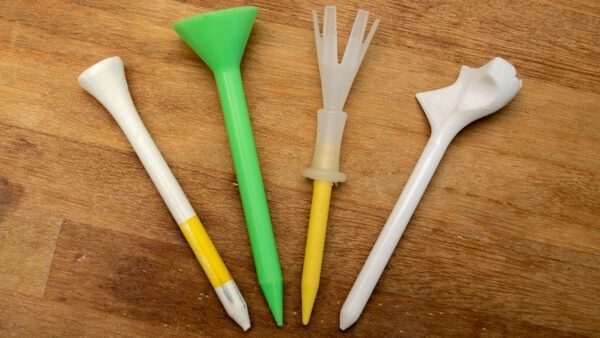2020 Golf Tee Test
Is there really such thing as a better golf tee?
Tee companies have been telling golfers for years that they can add distance and accuracy to your game. So, to see if there is anything to these bold claims, we put them to the test. We put 4 tees to a head-to-head test. We tested the 4 Yards More, FlightPath, Martini and the standard wooden tee.
For the better part of a century, the fundamental design of the golf tee has remained largely unchanged. A peg, a platform and, well, that’s basically it. A hundred years of history suggests that simple as it may be, it works pretty well.
As with any other piece of golf equipment, however, there are challengers. Wood gave rise to plastic, which spawned eco-friendly alternatives, and other alternative designs with fresh (and sometimes unusual) takes how on to best support a golf ball before you whack it.
Many of these revolutionary designs claim quantifiable performance benefits over their wooden counterparts: Higher launch, lower spin, more distance and straighter drives … if you’re willing to pay a moderate upcharge. But, do they actually work?

Golf Tee Test – Parameters
For this golf tee test, we compared a standard wooden tee to three popular alternatives – FlightPath, Martini and 4 Yards More.
The test was conducted at MyGolfSpy’s test facility in Yorktown, Va Ball and clubhead data collected using a Foresight Sports GCQuad Launch Monitor All shots were hit with PING G410 LST driver and Bridgestone Tour B X golf balls For consistency, tee heights were normalized relative to ground level and tees were aligned in the vertical position In total, 120 drives were hit using each tee.The tee manufacturers don’t make identical claims so we’ve noted here where specific claims were made or implied.
FlightPath
Observations:
The FlightPath tee launched slightly higher and produced a slightly higher trajectory than wood. We did find evidence to suggest that FlightPath provides straighter ball flight than any of the tees we tested. We found no reliable evidence to support FlightPath’s other performance claims.Other Considerations:
FlightPath’s billing as “The Unbreakable Golf Tee” is simply not true. Four broke over the course of this test – that’s more than the other wood alternatives. Of the golf tees tested, FlightPath proved the most difficult to tee up without the ball falling off.Martini
Observations:
In this golf tee test, we found no evidence to support Martini’s distance claims. We found evidence to support a loss of distance. Data suggests a modest reduction in sidespin. However, it didn’t result in shots that were, on average, straighter than wood.Other Notes:
The Martini tee is the easiest to tee up, which does provide a benefit for golfers with limited range of motion or shaky hands. The Martini tee is phenomenally durable and its larger design and bright colors make it easy to find on the tee box. There is a legitimate reason why it’s popular with senior golfers.4 Yards More
Observations:
The data suggests that 4 Yards More is statistically identical to a wooden tee, we found no reliable evidence to support claims of improved performance. Durability claims appear to have some merit as we broke only a single tee over the course of the test.Other Notes:
4 Yards More is designed to achieve identical tee heights each time the ball is teed up. This could prove beneficial for golfers looking for greater consistency in their setup.Golf Tee Test – Do They Live Up To Their Claims?
Golf Tee Test Takeaways
While we did find hints of a slight performance advantage for a narrow set of metrics, we found no reliable evidence to suggest any of the alternative tees tested provides any significant benefit over wood. Nothing here is going to give you 10 more yards, but you probably knew that already.
Where advantages do exist, they’re largely matters of convenience.
As with anything else, there are preference-driven reasons why you might choose an alternative to wood. That’s perfectly reasonable but the data collected during this tee test suggests that, if improved performance is your objective, you’re not going to find it by spending more on a golf tee.
A century later, wood is still the tee beat.
The post Golf Tee Test appeared first on MyGolfSpy.
